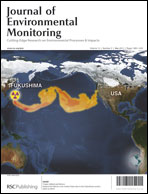Assessment of particulate matter in the urban atmosphere: size distribution, metal composition and source characterization using principal component analysis
Abstract
In this study, the size distribution of airborne particles and related heavy metals Co, Cd, Sn, Cu, Ni, Cr, Pb and V in two urban areas in Istanbul: Yenibosna and Goztepe, were examined. The different inhalable particles were collected by using a cascade impactor in eight size fractions (<0.4 μm, 0.4–0.7 μm, 1.1–2.1 μm, 2.1–3.3 μm, 3.3–4.7 μm, 4.7–5.8 μm, 5.8–9 μm and >9 μm) for six months at each station. Samples were collected on glass fiber filters and filters were extracted and analyzed using


 Please wait while we load your content...
Please wait while we load your content...